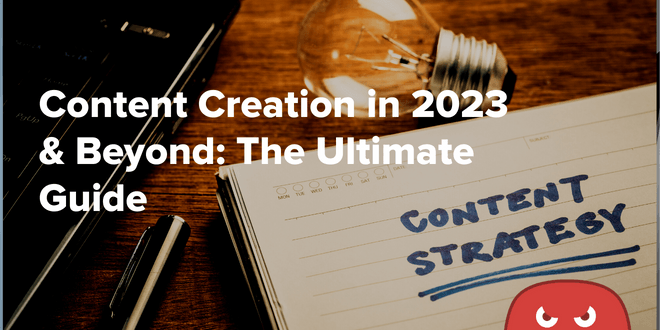Quick Links
If you want your target audience to discover your brand, products, and services in 2023 – digital content creation optimized for SEO is the #1 way to do so.
Why is that?
There are more than a few reasons why.
For one, 68% of online experiences begin with a search engine, and that includes potential shoppers. Also, organic search drives 53.3% of all website traffic, and creating high-quality content is the most reliable way to snag that traffic for yourself.
Another reason content creation is such a necessary marketing strategy in today’s age is the ineffectiveness of other marketing channels.
For instance, a majority of internet users aged 16 to 64 use ad blockers (42.7%), rendering any digital ads you paid for mostly useless. Not only that, but advertising on TV & radio is expensive and not an option for many small businesses and startups.
On the other hand, businesses of all sizes can write blog posts and shoot simple videos to generate traffic, leads, and sales – which is why content marketing strategies are so powerful.
With a little optimization & keyword research, your pieces of content will improve your visibility on search engines and social media, which is what you want.
If you’re brand-new to the content creation process, don’t fret because we’re here to teach you how to develop a winning content strategy, regardless of your budget. Stay tuned to learn how to start creating great content for your business.
Why Does Content Creation Matter?
Creating content is vital in today’s age because it’s the ultimate inbound marketing technique.
What’s inbound marketing?
It’s where you attract potential customers to your website instead of disrupting their online experience with intrusive ads and videos.
By creating valuable content that educates users and answers their most pressing questions, you will draw prospects straight to your website through search engines. From there, the strength of your CTAs (calls to action) and sales funnel will help you convert clicks into customers.
Content marketing is immensely popular due to how effective it is, with 67% (up 7%) of marketers reporting that content generates demand & leads, 72% (2% increase) reporting that it helps educate their audience, and 63% (3% increase) claiming it builds loyalty amongst existing customers.
The kicker?
These stats are all on the rise, with significant percentage increases since the previous year, meaning that content creation is becoming even more effective.
As you can gather from those statistics, content does a lot more for your brand than generate more leads & sales. Regularly releasing high-quality content will also:
- Generate brand awareness
- Establish your brand as a thought leader in your field
- Build loyalty and trust among customers
- Bolster your company’s reputation
All these reasons are why it’s worth investing in creating engaging content for your target audience – so it’s best to jump on the content bandwagon sooner rather than later. The good news is that creating a content strategy doesn’t have to be difficult or expensive, and even the smallest companies can do it.
That’s especially true with the advent of artificial intelligence programs capable of generating entire blog posts at the push of a button.
Reasons to Invest in Content Creation
While PPC ads are excellent for gaining short-term online visibility, you need an organic SEO strategy to go along with it. That way, once your content marketing efforts begin to take off, you can ease off the gas with your PPC campaigns, saving a considerable chunk of your budget.
Content marketing campaigns are also excellent for improving your visibility on not only search engines but also social media sites such as LinkedIn, Twitter, and Facebook.
In today’s age, a majority of people are online instead of tuning into television or radio (more than 8 in 10 Americans exclusively use the internet for news and media), which is why creating online content is the best way to get the word out about your business.
Bearing that in mind, here’s a look at some of the top reasons to invest in content creation.
Reaching the unreachable
As stated before, many adults choose to browse the web with ad-blockers, rendering most digital online ads obsolete.
How do you reach these users?
You can reach them by creating the kind of content that they will actively seek out and consume on their own, which is the core principle behind inbound marketing.
If that sounds confusing, consider this example of a typical internet user that can’t stand online ads. Whether it’s a brief ad before a video or a pop-up, they can’t click away fast enough, and they have every ad blocker known to man.
While it may seem impossible to advertise anything to them, the right types of content will have them reaching for their debit cards.
Let’s say that they love to fish, and you sell fishing rods and equipment. Instead of disrupting their experience with an ad (that they’ll click off of anyway), you produce a mix of helpful blogs and videos covering popular fishing topics.
One day, the user wants to learn more about fly fishing, and they come across a blog you wrote entitled ‘The Ultimate Guide to Fly Fishing.’ They read the post from top to bottom and noticed a convincing CTA at the end:
Want to get started fly fishing? Don’t wait to check out our collection of high-quality rods today.
They click on the link and immediately place an order for a new fly fishing rod. That’s the power of content creation in a nutshell, and it’s how you can reach the unreachable.
Improve your online visibility
Having a website won’t amount to much if nobody is able to find it. If your website isn’t in Google’s index, it may as well not even exist.
Search engines are the #1 way that users discover new websites, which is why SEO is such a big deal amongst digital marketers. Yet, being indexed by search engines is only the beginning of the battle, as ranking below the top 20 results is almost equal to not even being indexed.
Rising through search engine rankings is no easy feat, which is why content creation is such a coveted practice amongst SEOs.
There’s no better way to improve your online visibility than by creating a large volume of high-quality website content that’s relevant & valuable to your audience. Good content also makes it far easier to acquire high-authority backlinks, which are a necessity for high SERP rankings.
Essentially, your content is what drives your SEO strategy and brand-building efforts.
Also, the more excellent content you release, the more visibility you’ll gain on social media platforms as well. As a rule of thumb, every time you release a blog post, podcast, infographic, or video – release it on all your social media platforms at the same time to maximize visibility.
Consistently generate leads & conversions
The great thing about content is that once it’s published, it will continue generating leads and sales for you for many months to come.
In other words, the one-time expense of creating content will pay off more than once, assuming that the content is high-quality and relevant.
Lead magnet tools like white papers and eBooks will consistently provide leads for your sales team, and convincing CTAs will continue to land sales well into the future. Once a piece of content becomes outdated, simply updating it will make it relevant again, and it will go back to generating traffic for your business.
By creating content for each stage of the sales funnel, you’ll be able to cater to potential customers that are ready to buy – as well as educate customers that are still in the research phase.
The Most Popular Types of Content
It should be clear by now that content creation is well worth your while, so you’ll need some content ideas to get started.
When most people think of online content, they tend to think of blogs, but that’s only the tip of the iceberg. In addition to blogs, there are whitepapers, eBooks, videos, infographics, podcasts, webinars, case studies, social media posts, and many others.
How do you know which type of content to create?
 That will depend on a few factors, including your budget, the needs of your target audience, and what you hope to achieve from the content.
That will depend on a few factors, including your budget, the needs of your target audience, and what you hope to achieve from the content.
For instance, if you want to collect email addresses from users, offering a free eBook is a great choice. If your goal is to wow and entertain your audience, then fun & engaging video content is the way to go.
Here’s a look at some of the most popular types of content you’ll encounter when browsing the web.
Blog Posts
Blogs are the most common type of content you’ll run into online, which is due to how inexpensive they are to create and their versatility.
They can take the form of listicles, reviews, opinion pieces, product showcases, and so much more. Blogs can be formal, informal, humorous, and any other tone you want to take with your audience.
Blogging is a highly effective form of content marketing, as businesses that produce blog content receive 55% more visitors than ones that do not, and they generate 67% more leads each month.
However, there are more than 600 million blogs online, which will undoubtedly include thousands of blogs within your niche, so you’ll need to find a way to make your content stand out.
Here are a few quick blog post ideas you can use to create new content.
Answer questions relevant to your target audience
If you want your blog to generate clicks, your content needs to provide real value to your audience – and one of the best ways to do that is to answer your audience’s questions about your field of expertise.
What kinds of questions is your audience asking?
To find out, you can venture to websites like Reddit & Quora and search for your niche. From there, pay attention to the questions you see asked over and over again, and then create blog content answering them.
This is a highly effective technique because you intercept prospects looking for answers to their questions, and you get to introduce them to your brand, products, and services.
Facebook Groups are also goldmines for uncovering the top problems your target audience faces on a daily basis. By answering their questions and solving their issues through helpful blog content, you’ll start to be seen as a thought leader. As such, anytime your audience has questions related to your niche in the future; your blog will be the first place they check.
Another tactic is to type a question about your niche into Google and then check the ‘People Also Asked’ section for more questions relevant to your audience. These questions are valuable because they’re real questions your prospects asked Google, so they’ll make perfect blog topics.
Create a listicle
The most popular blog format online is an odd-numbered listicle, so don’t hesitate to join the craze if you need to generate more traffic.
A big reason why they work so well is the attention-grabbing nature of a listicle’s headline. They’re also very scanner-friendly, enabling readers to quickly scan each numbered subheading to determine if reading the entire post is worth their time.
The great thing about listicles is they work for just about any topic, regardless of industry.
Going with the fishing example from before, you could develop all sorts of listicles, such as ‘The Top 5 Reasons to Try Fly Fishing,’ ‘The 13 Best Fishing Rods You Have to Try,’ and ‘6 Reasons You Need to Change Your Bait.’
As you can see, each listicle covers a different topic, and the number in the title makes them stand out more.
As such, listicles should comprise a large portion of your blogging strategy because of how good they are at catching readers’ attention.
How-to tutorials
Another highly popular blog format is the classic how-to post, where you teach readers a new skill in a step-by-step breakdown.
How-to posts are excellent because they cater to the core principle of inbound marketing – getting your customers to come to you. If you can uncover the things your target audience wants to learn how to do the most & create tutorials for them, they’ll come flooding to your website in droves.
For all the anglers that have never used a fishing lure before, writing a detailed blog tutorial on how to fish with lures will generate lots of traffic.
Before you create a how-to blog post, ensure that the method you’re going to teach is safe, accurate, and reliable. The last thing you want is to give your audience unreliable advice, which will tarnish your reputation instead of improving it.
Videos
In 2023, videos are set to account for 82.5% of all web traffic, making it the most popular type of content online.
That means no content marketing strategy is complete without including some sort of video content, as companies can no longer afford to ignore the prevalence & popularity of online videos.
Visual content is easier for users to consume, and video production has become rather inexpensive, so even smaller companies can join in on the fun. With an iPhone and some basic editing software, you can create informative & engaging videos to go along with your blog posts and infographics.
Like blog posts, videos are highly versatile, as they can inform, educate, entertain, and more.
Also, you can tweak some of your blog ideas to make them work as videos instead. So the next time you sit down for a content brainstorming session, don’t forget that listicles and how-to tutorials can just as easily be videos as blog posts.
Podcasts
Content creators shouldn’t forget about podcasts, as there are 464.7 million podcast listeners worldwide as of 2023.
People love listening to podcasts while commuting to work, completing menial tasks, and exercising – making them a fantastic way to reach your audience. Like videos, podcasts are relatively inexpensive to produce since all you need is a mic and an internet connection.
There are thousands of online podcasts spanning all industries, from financial planning to real estate and many more.
A tried and true podcast format is to interview influencers and notable figures from your field to provide your audience with value. You can also use your podcast to discuss current trends, answer questions from listeners, and hold special contests and giveaways.
Infographics
An informative infographic is one of the most powerful content types for acquiring high-authority backlinks. If you’re able to compile relevant statistics and figures in a fun & interesting way, other bloggers will want to link to it in their posts, which will boost your SEO profile.
They’re also fantastic for sprucing up plain-text blog posts.
By including infographics with top-notch graphic design, your readers will have something visual to interact with, which will break up the monotony of walls of text.
Besides using infographics to display statistics, you can also use them for visual storytelling, which can have a powerful effect on your audience.
For instance, if you’re able to convey the benefits of one of your products or services in a visual way using graphics, it’ll have more impact than using static text.
Developing a Content Creation Strategy
Now that you’ve got some content ideas, it’s time to learn how to put a proper strategy together. After all, you can’t just start randomly creating and releasing content.
Rather, you need to employ a meticulous strategy that entails forming a content creation team, setting clear goals, developing an editorial calendar, and then creating the content.
You’ll also need to use keyword research tools to help you develop content that your audience wants to consume, like our free keyword planner tool from The HOTH.
Setting realistic goals
Your goals form the foundation of your content strategy, which is why you should begin by setting SMART goals.
That stands for Specific, Measurable, Attainable, Relevant, and Time-Bound, and it’s the perfect acronym to use to transform a generic goal into an actionable one.
Here’s a quick example of how to use it:
- Specific: We want to increase organic traffic
- Measurable: We want to see a 25% increase
- Attainable: We have a promising content strategy in place
- Relevant: Increasing our traffic will help build our brand
- Time-Bound: We want to see the increase within six months
Now you have a highly detailed goal for your strategy, along with a timeframe to make it happen. You shouldn’t stop at just one goal, though, so feel free to use the SMART acronym to form as many goals as you need to grow your business.
You should think of your goals with every piece of content you create. Before you invest time and resources into developing a blog post or video, ask yourself, “How is this going to get us closer to our goal?”
Form a content creation team
Next, you need to determine who’s going to create your content. Do you have the resources to hire an in-house content creation team, or do you plan on outsourcing the work to freelancers? Either way, figuring out how you plan to create content is crucial before taking the next step.
If you don’t have the budget for freelancers or in-house content creators, you can choose to use AI to generate content, or you can do it yourself.
If you need help creating graphics, Canva is an excellent content creation tool for generating graphics and copyright-free stock images.
Once you’ve assembled your team, you’ll need to create an editorial calendar containing all your content ideas and publishing deadlines. Content planning is equally as important as content creation, so don’t forget to map out your content strategy.
Project management tools like Asana are excellent for keeping your content creation team on track, as they make it effortless to assign & review tasks from one location.
Promote your content online
Once you start publishing content, you’ll want to have a plan in place for promoting it. If you only release blogs on your website, the chances are they won’t gain much traction without any promotional efforts.
 This is where it helps to truly understand your target audience.
This is where it helps to truly understand your target audience.
Where do they spend most of their time online?
If they’re always on Reddit or Facebook Groups, make a post promoting your new content. Also, don’t forget to share all the content you create on all your respective social media channels, as well as email it to your contacts/newsletter members.
Lastly, keep an eye on essential metrics like your organic traffic, click-through rate, dwell time, bounce rate, and average ranking position through tools like Google Analytics and Google Search Console. If you don’t see the results you want, it’s time to go back to the drawing board.
Final Thoughts: Content Creation in 2023 & Beyond
Creating the best content you can is the #1 way to increase online visibility, generate more leads, and convert more prospects.
Content creation is the ultimate form of inbound marketing, and when done right, your content will continue earning revenue for you well beyond the date you publish it.
Do you need expert assistance creating a winning content strategy for your business?
Then don’t wait to check out our top-tier content creation services at The HOTH. In addition to producing engaging videos, blogs, and website content – we also offer managed SEO services at HOTH X, so don’t wait to try us out today.














Fantastic post, yes research is ghe key, so is full-time but once you have it done right you will see the benefits. Lots of things to think about. Thankyou.
Hey Alison,
Thanks! Research is SO important, without it you lack the foundation you need to actually be competitive. Glad you found the post valuable, and you can hit us up for help with your content creation any time.
Good one! Lot of info!
Great article! Was good to learn about content creation!
Gratitude for joining us on an enlightening exploration of Content Creation in 2023 & Beyond! Thank you for embracing the valuable insights and strategies shared in this ultimate guide. Let’s elevate our content game together!